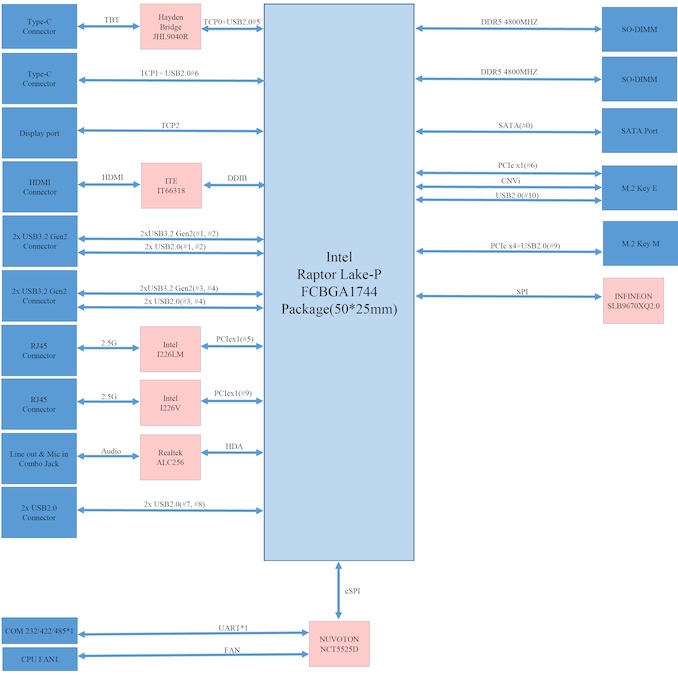ASRock Industrial NUC BOX-1360P/D5 Review: Raptor Lake-P on the Leading Edge
by Ganesh T S on July 18, 2023 10:30 AM EST- Posted in
- Systems
- Intel
- UCFF
- Mini-PC
- ASRock Industrial
- Raptor Lake-P
Setup Notes and Platform Analysis
Our evaluation of the NUC BOX-1360P/D5 (after completion of the build using the G.Skill SODIMMs and Samsung M.2 SSD) began with a look at the options available in the BIOS interface. As is typical for systems targeting the industrial market primarily, the main BIOS interface is a vanilla one. It does provide plenty of configuration options. The video below presents the entire gamut of available options.
The key feature is under Advanced > CPU Configuration > CPU Operating Mode, with the option to either keep it at 'Normal' or change it to 'Performance'. The latter setting increases the power budget available to the processor.
The block diagram below presents the overall high-speed I/O distribution.
The key updates over the NUCS BOX-1360P/D4 are evident in the above block diagram. The JHL9040R retimer enables DisplayPort 2.1 support as well as USB 3.2 Gen 2x2 (20 Gbps) support on the Thunderbolt 4 Type-C port. The HDMI port uses a ITE IT66318 retimer. Realtek ALC256 fulfils the analog audio codec duties. A dedicated SATA port is brought out on the board along with the required power pins. A TPM device from Infineon communicates over a SPI interface with the Core i7-1360P.
There is a lack of flexibility on the board design side for the HSIO lanes allocation due to the integration of the PCH inside the package. Despite that, ASRock Industrial has delivered a compelling set of I/O options given the form-factor constraints. Making both Type-C ports in the front panel to be Thunderbolt 4-capable would have been a welcome improvement over the previous Intel-based UCFF systems from the company.
In today's review, we compare the NUC BOX-1360P/D5 and a host of other systems based on processors with TDPs ranging from 15W to 35W. The systems do not target the same market segments, but a few key aspects lie in common, making the comparisons relevant.
| Comparative PC Configurations | ||
| Aspect | ASRock NUC BOX-1360P-D5 (Performance) | |
| CPU | Intel Core i7-1360P Raptor Lake 4P + 8E / 16T, up to 5.0 GHz (P) up to 3.7 GHz (E) Intel 7, 18MB L2, Min / Max / Base TDP: 20W / 64W / 28W PL1 = 40W, PL2 = 64W |
Intel Core i7-1360P Raptor Lake 4P + 8E / 16T, up to 5.0 GHz (P) up to 3.7 GHz (E) Intel 7, 18MB L2, Min / Max / Base TDP: 20W / 64W / 28W PL1 = 40W, PL2 = 64W |
| GPU | Intel Iris Xe Graphics (96EU @ 1.50 GHz) |
Intel Iris Xe Graphics (96EU @ 1.50 GHz) |
| RAM | G.Skill RipJaws F5-4800S3434A16GA2-RS DDR5-4800 SODIMM 34-34-34-76 @ 4800 MHz 2x16 GB |
G.Skill RipJaws F5-4800S3434A16GA2-RS DDR5-4800 SODIMM 34-34-34-76 @ 4800 MHz 2x16 GB |
| Storage | Samsung SSD 980 PRO (500 GB; M.2 2280 PCIe 4.0 x4 NVMe;) (Samsung 128L V-NAND 3D TLC; Samsung Elpis Controller) |
Samsung SSD 980 PRO (500 GB; M.2 2280 PCIe 4.0 x4 NVMe;) (Samsung 128L V-NAND 3D TLC; Samsung Elpis Controller) |
| Wi-Fi | 1x 2.5 GbE RJ-45 (Intel I226-LM) 1x 2.5 GbE RJ-45 (Intel I226-V) Intel Wi-Fi 6E AX210 (2x2 802.11ax - 2.4 Gbps) |
1x 2.5 GbE RJ-45 (Intel I226-LM) 1x 2.5 GbE RJ-45 (Intel I226-V) Intel Wi-Fi 6E AX210 (2x2 802.11ax - 2.4 Gbps) |
| Price (in USD, when built) | US $700 (barebones) US $840 (as configured, no OS) |
US $700 (barebones) US $840 (as configured, no OS) |
The rest of this review deals with the comparative benchmark numbers for the UCFF systems outlined in the table above. All of the systems are based on 4"x4" motherboards, though the PL1 and PL2 configurations vary.











21 Comments
View All Comments
abufrejoval - Monday, July 24, 2023 - link
What irritates me immensely is that AMD NUCs only ever become available with the previous generation APUs (or older yet).With Intel NUCs actually tended to lead with the latest generation chips, sometimes even giving you variants that were hard or impossible to get even as a notebook.
Plenty of people will be quite happy with Cezanne, and that's great as an economical industrial option. But for a bit of extra money, I'd like to be able to get a Zen 4 NUC today, not when Zen 5 is coming out.